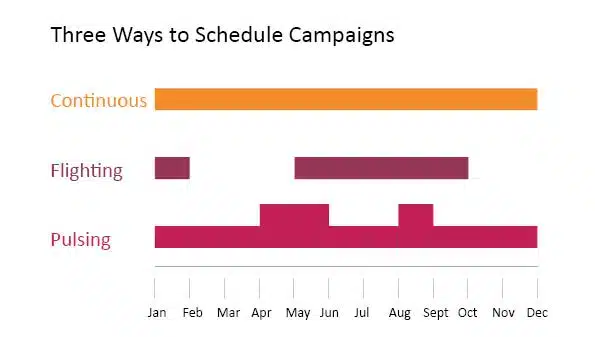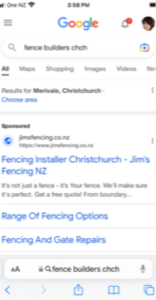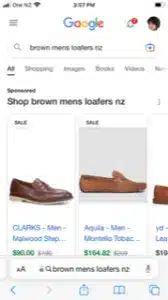
If you’re looking to boost next quarter’s sales, to promote for Christmas, or to plan in advance for a big push, you might be wondering what is the best digital marketing campaign to use.
In this article, I’ll cover 8 types of digital marketing campaigns and which ones to use to boost Spring, Summer or Christmas revenue for different companies. The 8 types of campaigns I’ll cover are:
1) Facebook campaigns (including Instagram)
2) Google Search Ads
3) Google Discovery Campaigns
4) Google Display Campaigns
5) Google Remarketing
6) Google Shopping
7) LinkedIn campaigns
8) TikTok campaigns
First, here’s a tiny bit of media theory.
If your enquiries are steady through the year, with no obvious peak, then an “always on” continuous campaign – especially Google Search ads – is the way to go. Of all the different campaigns, Google Search is my go-to for most clients, because Search ads reach prospects who are further down the readiness funnel to buying. Therefore, the conversion rates from these are typically higher. If you have an ecommerce site, then Google Shopping could also fall in this “continuous” category. If your product has a long decision time frame or a high value product, Google Remarketing might be one to keep “always on” too.
If your business has seasonal peaks e.g. retail around Christmas, tourism shoulder seasons, education enrolments or gym January membership drives, then flighting is ideal. You can turn it off as the season concludes e.g. a few days before Christmas in time for last shipping. All the campaign types are suitable for flighting, but I’ll go through the nuances shortly. Some campaigns use AI, and take a few weeks to learn what works before they really start cranking, so if you want to be cranking in late Nov/Dec, then I’d advise you to get cracking before the end of October.

Pulsing suits clients who may have an all-year product with stronger periods, or an extended season that builds into a peak in a certain month. Agriculture and tourism are good examples. Construction is also a sector where this works (lots of people have time to browse in January, even though they may not be ready to enquire).
Facebook is one of the biggest social media platforms in NZ, and is particularly strong in reaching women 40-60. It’s not my choice for under 30-year-olds (Instagram holds sway here). Nor is it strong for male business owners 45+. However, it still does surprisingly well for us in reaching farmers! Facebook’s strong suit is around fashion, beauty, apparel and lifestyle. However, don’t rule it out for B2B audiences.
The campaigns that have worked well for us recently have been based on video ads, reels and carousel ads targeting a specific gender, age group and interest area. With campaigns, it’s good to think about where it will lead to e.g. forms, Messenger chats or landing pages. The challenge is that for some reason, many leads are more “flighty” and less “sticky”. It is an entertainment platform where people go to catch up with news on friends and chill out. So they’re not in a shopping mindset when they’re here. Though under 30’s do shop and browse (especially fashion) on Instagram and Facebook. The combo of Facebook with a Google Discover campaign seems to work well.
I think Facebook & Instagram campaigns are a great way to build brand visibility, engagement and get people into the top of your funnel. But if you’ve never done Google Search ads, and you need to get some runs on the board, I would start with Google Search BEFORE a Facebook campaign.
If you’ve got a Shopify site, then Facebook remarketing is worth looking into.
In saying that, in the rare case that your product is a new category that doesn’t have a pool of people already searching for it, then Google Search Ads is not the answer.
Boosting is largely necessary to get your posts to show to your existing audience, but campaigns are the answer when you want to expose your products to new audiences.
Another consideration is that since the rebranding to Meta, the advertising platform has undergone many changes which unfortunately, have not made it more user-friendly. For the campaigns to work best, you need your Facebook pixel set up (ideally through Tag Manager with the Google GA4 tag), and to make sure you have control over your Business Ads account. Our team have been busy recovering and helping clients with this process, necessary before we set up campaigns. Some Facebook campaigns may also require you have a privacy policy page on your website.
In the past, sometimes an agency would manage your account. The current best practice is that someone inside your organisation needs to have the super admin, and then they invite agencies to be a partner. There’s a limit on how many accounts you can administer.
So if you’re planning a Facebook campaign, start now as if your tags and control is not in hand, it could well take two weeks to get these in order.
Of all the campaign types, this is the one that for us is the most guaranteed to perform. I think this is because if someone is entering a search phrase, they have already decided to do some research. Whereas in Facebook, Google Discover/Display and LinkedIn, unless they’re following or searching for a specific hashtag, then who knows if they’ll be interested. It’s like selling gas fires to home owners. On Facebook, I don’t know if they’ve got a gas fire or not. But if they’re searching for gas fires on Google, then I know I’m speaking to a more “ready to buy” audience. And if they’re searching “buy gas fire” or “gas fireplaces Christchurch”, then I know they’re an even hotter lead.
Google search ads allow you to reach a defined geographic area, and we can put different budgets on closer areas more likely to convert, vs further away regions. If you’re a tourism operator, people in the next province are more likely to convert than people at the other end of the country. And Australians are – in general – more likely to convert than Germans, for example.
Perhaps you have a number of different products, but some are core or higher value, and your favourite type of project. So we can turn up or down the focus.
You can also put different emphasis on specific product groups. So when you find the top performing keyword phrases and ad groups, you can channel more energy into these – and watch the results flood in.
The great thing about Google Ads is that you’re not committed to a fixed spend; you can turn it up when you’ve got capacity or it’s your busy season, and turn it down – or off – when you’re full, or the season has finished. I had one client who had to cancel
Yes, some people do use ad blockers. Native ads via digital newspapers are a solution if you’re worried about this. Around 15% of all clicks on Google Search queries are on ads. So yes, you’ll do better from search optimisation which gets the balance of clicks (we can help with that too) but Google ads allow you to appear on page one instantly, without the delay seo takes. But then SEO delivers clicks at no cost, and with Google ads, you’ll have to pay for each click. (Plus, the results from your Google ads deliver some amazing insights for doing search marketing as a next step).

These are a bit like the online version of newspaper ads but with more precise targeting. Google knows what our interests, gender and age are, based on our browsing behaviour. So you can say “Google I want to reach dairy farmers, aged 35-60” and bingo, your ads show to a defined audience. Google Display ads include Youtube video ads, and show on partner sites that have set up a spot for Google advertising. Some of the well-known news sites share their spare inventory with Google (so you can get visibility on these platforms for a fraction of the cost of booking directly).
Google Display ads are, like Facebook, reaching people at the top of the funnel, though you can also advertise to an “in market” audience e.g. someone currently shopping for gas fires. I’ve used Google ads successfully for a wide range of clients. The typical balance is to have Google Search ads “always on” and to run a Google Display ad as a “flighting” seasonal promo – ideal for Christmas.
If you were Google, you’d see Facebook as a major competitor, stealing lots of advertising dollars. So Google has come up with its own competitor to Facebook, and the ads are a fraction of the price. You can download a Google app on your phone (to search with). This then has a Discover feed, much like a Facebook feed, which shows content related to stuff you’ve been searching. So if you do a Google Discovery campaign, your ads show to people using Gmail, on Youtube, and on the Google App on phones. The plus is, these ads use AI learning. So for three weeks, things are a bit slow. Then hey presto, after three weeks, Google has worked out who clicks on your ads and then matches them. Your clicks go through the roof, and the cost per click comes down.
The minus is, the audience is not as broad as Google Display or Facebook. But hey, at 25% of the cost per click of Facebook (for the campaigns we’ve done), we rate it. Just make sure you start in time to get the benefit after the three weeks of learning.
Google Shopping Ads  You’ve seen the images ads when you do a search on your phone? Google Shopping ads are an important ad method for ecommerce sites. The plus: They show an image, filtering out those who don’t like the look of your product. And they show right at the top of the screen. The minus: by the time you work out your cost per acquisition, it could start out high like $25, and then as you work out what works, the cost goes way down. But if your product is low cost with low margin, then it may not pay its way. On the other hand, if your average sale includes a margin that covers ad costs, and your ongoing marketing is strong (so lifetime client value is high), then it can be worth taking a hit to get the customer through the door. Google says in general not to have more than 30% of your search budget assigned to Google Shopping ads.
You’ve seen the images ads when you do a search on your phone? Google Shopping ads are an important ad method for ecommerce sites. The plus: They show an image, filtering out those who don’t like the look of your product. And they show right at the top of the screen. The minus: by the time you work out your cost per acquisition, it could start out high like $25, and then as you work out what works, the cost goes way down. But if your product is low cost with low margin, then it may not pay its way. On the other hand, if your average sale includes a margin that covers ad costs, and your ongoing marketing is strong (so lifetime client value is high), then it can be worth taking a hit to get the customer through the door. Google says in general not to have more than 30% of your search budget assigned to Google Shopping ads.
These are ads that show to people who have already been on your site. Had a brand stalk you? Yep. Google remarketing. Ideal for long lead services like residential builders. The click through isn’t high, but the cost is tiny, and it’s a good way to get your brand known and stay top of mind. Your ads can be more “nurturing” or “close the deal” type ads, since people have already visited your service. Brilliant ad on to Google Search Ads. Here for your next step into Google Ads.
I like LinkedIn campaigns when my target audience is defined by the industry or job title. LinkedIn is the most successful campaign type for B2B companies. The downside is that the cost per click is significantly higher than Facebook or Google. LinkedIn is also a good place to run a recruitment campaign. I like LinkedIn for targeting managers and professionals – and for getting exposure to internationals in a specific industry. It’s very good for reaching marketers. LinkedIn has a strong reach to 25-35 year olds. There is still a bunch of trade CEO’s aged 55-70 that are hard to reach online, if they’re not computer savvy (many are very computer-savvy these days). I’d look to trade associations to reach them.
With TikTok ads you have the usual range of reach, traffic, video views, product sales, website conversion, lead generation and app promotions, and retargeting. Depending on the objective and placements you choose, your ads may appear in four places: In-feed, Detail Page, Post-roll, and Story.
A pulse campaign enables you to run in-feed ads in the highly trending, engaging, and brand-safe content that make up the Top 4% of videos on platform. Spark Ads – boost different types of videos to maximise their impact, either your own, creator-made, or ones that mention your brand.
It comes down to what you can afford. Bigger clients typically spend $3-5k a month, medium clients $1600-$2,850k a month, and small clients $850 to $1400 a month. The period varies according to your product seasonality and results. You don’t have to sign your life away. You can dip a toe in the water, and then extend it as your confidence grows.
Set up time by us for a campaign on a single platform varies from $3k to $1500. Most campaigns require monitoring each month to get the best performance. A recent challenge has been that if you haven’t got your tags in order, this can be fiddly and may take $500-$1800 to tidy, depending on how messy things are. Once the tags are sorted, then this is done and dusted for all future campaigns.
If your audience is under 30, 100% online. If 31-50, I’d swing most of the budget online. For those aged over 70, I’d have over half in print. There are some industries where I think print is important: farmers for one. Farming rags and local newspapers are well read esp by sheep and beef farmers whose average age is 58 (dairy farmers’ average age is younger, so they’re pretty savvy online). But farmers go online every day to check the weather! Pensioners didn’t grow up with computers so online is less mainstream.
Industry magazines are a great way of reaching niche markets (but associations usually do newsletters). The challenge is measuring the return on investment. Most clients find that print ads don’t give the same return that they used to. Trials of moving 100% to digital have delivered similar sales, for a fraction of the spend and within a much shorter time frame.
If your campaign is directed to your website, then edits may need to be made to ensure the landing page from the campaign is relevant and has a clear path to action. And tags set up so you can measure conversions. Start early to avoid being caught short.
Plan ahead in each month for upcoming events:
| Jan | Feb | Mar | Apr |
|---|---|---|---|
| Lose weight Wedding invitations Back to school End of financial year Pools Student accom |
Cinema searches for Easter hols Gas fireplaces & heating Textbooks Tutoring Health insurance |
Mother’s Day Easter opening hours Weddings |
Holiday accom for Christmas Gas for winter Accountant Spa & Beauty services Flowers for Mothers Day |
| May | Jun | Jul | Aug |
| School holiday accommodation for July hols Gas Snow products & activities |
Book accom for Sep school holidays Cold & flu Knitwear Skiing |
Football finals tickets Indoor activities What’s on |
Prepare for Spring garden/soil/landscaping supplies Father’s Day DIY season Wedding planning |
| Sep | Oct | Nov | Dec |
| Jewellery (rising from mid Nov) Casual jobs (peaks at end of Nov) Xmas party venues Soil Paint |
Food & Seafood (for the big Xmas feast) Christmas gifts How to DIY’ers (strong end Oct) Paint |
Christmas shopping Easter Streaming subscriptions |
Summer holidays Christmas Shopping Back to school Valentines Day School Holidays Builders/home products (highly searched in Jan) Camping Jewellery |
Interested to explore one of these campaigns further? Don’t leave it til the last minute if you want to leverage the AI capabilities and get your tags in order 😊 It’s good to have at least two weeks or a month up our sleeve for major campaigns, in case of unforeseen hiccups. We can arrange Google Search ads with a much shorter lead time.
Next starts now. Chat with our team at our digital marketing agency in Christchurch; we will give your campaign the insights and attention it needs to succeed.
Rachel